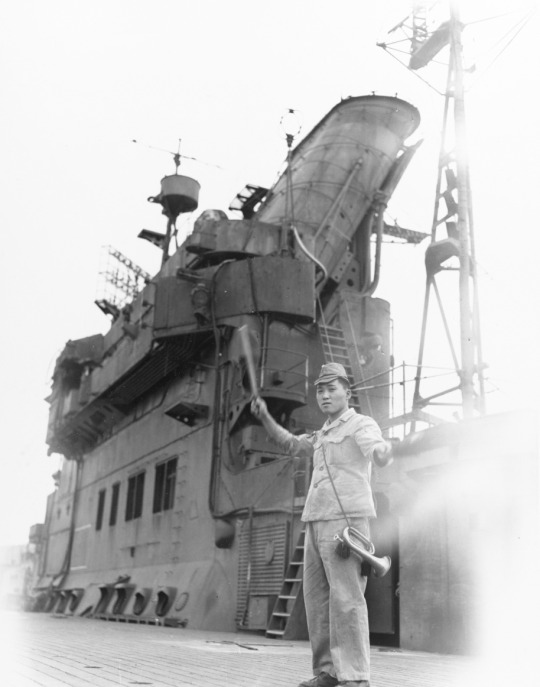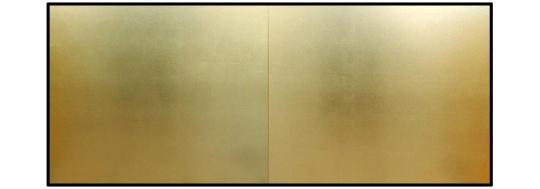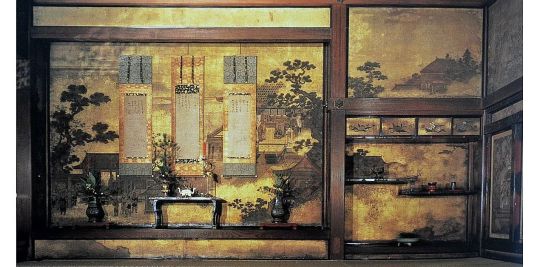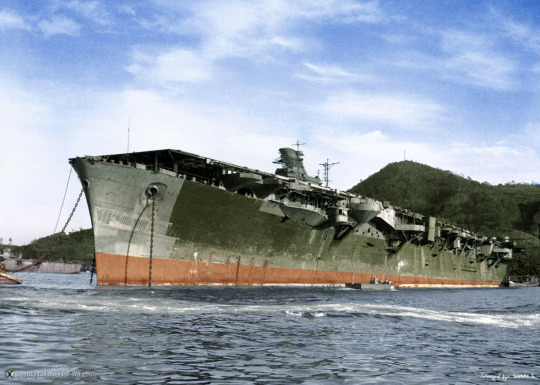#Hiyō Class
Text

A member of the residual crew of Japanese Aircraft Carrier Jun'yō (隼鷹) signals an approaching tug from the carrier's flight deck. Photographed at Sasebo, Japan.
Note this Japanese Signalman's bugle, and details of the ship's island.
Date: October 19, 1945
NHHC: SC 218541
#Japanese Aircraft Carrier Jun'yō#Jun'yō#Hiyō Class#Japanese Aircraft Carrier#Aircraft Carrier#Warship#Ship#Imperial Japanese Navy#IJN#Sasebo#Japan#postwar#post war#October#1945#my post
31 notes
·
View notes
Text
Nampō Roku, Book 5 (68): Concerning the Daisu-saki Byōbu [臺子先屛風]¹.

68) With respect to the folding screen that encloses [two sides of] the daisu, a two-fold screen, or a six-fold screen -- either may be used. The Higashiyama-dono also used both kinds². These [screens] were always [covered with paper that was] gilded³, or speckled with gold or silver flakes⁴, or painted with [faint horizontal bands of gold or sliver resembling] clouds, and the like⁵.
It is also acceptable to try using [screens on which] poems and the like [have been] inscribed by [a person] famous for their beautiful writing⁶.
But, because paintings are often hung [in the tokonoma], or because [many] rooms feature paintings on the wallpaper, such [screens] are not used [in chanoyu]⁷.
〇 (Appended [to the preceding]⁸:) with regard to the height of the screen, when the temmoku is rested on its dai, and displayed [on the ten-ita of the daisu], it should not be visible [from the other side of the screen]⁹.
_________________________
◎ The complete text of the entry is as follows:
〇 daisu-saki no byōbu ha, ni-mai-ori・roku-mai-ori izure mo hiyō-sōrō, Higashiyama-dono ni te mo tōri o-yō-sōrō, izure mo kin-ji・sunago ji arui ha unbiki nado no muji arui ha nō-sho no uchi-tsuke-gaki・waka nado yoshi to su, e ha kaki-e mata e-no-ma ni sashi-awase koto ōshi yue ikenai nari
[臺子サキノ屛風ハ、二枚折・六枚折イツレモ被用候、東山殿ニテモ二通リ御用候、イズレモ金地・砂子地或ハ雲引等ノ無地或ハ能書ノ打付書・和哥ナトヨシトス、繪ハ掛繪又繪ノ間ニサシ合コト多故不好也].
〇 (tsuke) byōbu no takasa, temmoku wo dai ni nosete kazari-taru ka mienu-hodo ni subeshi
[(付) 屛風ノ高サ、天目ヲ臺ニノセテ飾タルカ見ヘヌホトニスヘシ].
¹Daisu-saki byōbu [臺子先屛風] refers to the folding screen that is usually called the furo-saki byōbu [風爐先屛風] today -- even when the screen surrounds the daisu.
The origin of this practice of enclosing the far end of the utensil mat with a folding screen began with the daisu.
²Daisu-saki no byōbu ha, ni-mai-ori・roku-mai-ori izure mo hiyō-sōrō, Higashiyama-dono ni te mo ni-tōri o-yō-sōrō [臺子サキノ屛風ハ、二枚折・六枚折イツレモ被用候、東山殿ニテモ二通リ御用候].
Ni-mai-ori [二枚折] means a screen of two panels, that is folded at right angles to surround the daisu on the far side, and the side facing the katte. A byōbu of this sort is shown below, under footnote 3.
Roku-mai-ori [六枚折] refers to a screen composed of six panels. Three panels are arranged, accordion fashion, on the far side of the daisu, and three are on the katte-side of the utensil mat, with the middle fold bent at a right angle. An example of this kind of byōbu is shown in the photo that is attached to footnote 5.
Ni tōri [二通り] means both kinds. In other words, Ashikaga Yoshimasa used both kinds of folding screens as his daisu-saki byōbu. When performing tea in a room like the Dōjin-sai shoin, he would have placed a ni-mai-ori byōbu around the daisu (between it and the walls on both sides); and when serving tea in a section of a larger hall*, he would have arranged a six-fold screen around the daisu (to enclose a section of the larger space for his purposes).
___________
*Yoshimasa’s practice was later taken as the precedent for the kakoi [圍い] that became a hallmark of Nobunaga’s style of chanoyu.
³Kin-ji [金地] means paper that is covered with square leaves of gold.

The above ni-mai-ori byōbu [二枚折 屛風] is covered with kin-ji kami [金地紙].
⁴Sunago-ji [砂子地] means white or cream-colored tori-no-ko kami [鳥の子紙] on which flakes of gold, silver, and/or mica (sometimes only one kind is used, sometimes two or more are mixed) have been sifted.

The flakes may be sprinkled heavily or lightly, and the size of the individual flakes also varies from tiny to substantial, as seen in the above examples.
⁵Kumo-biki [雲引] means the same sort of (usually white or cream colored) tori-no-ko paper* mentioned in the previous footnote, to which faint horizontal bands of gold, silver, or white pigment have been applied (often stippled against a stencil of some sort, giving an air-brushed effect).

The resemblance to banks of clouds varies from literal, as in the above photo of a kumo-biki roku-mai-ori byōbu [雲引六枚折屛風], to suggestive (sometimes the “clouds” are little more than horizontal lines that trail away on the lower edge).
___________
*Sometimes kin-ji kami [金地 紙] is used as the base for kumo-biki (as seen in the above example) -- though the use of so much gold became fashionable from the Momoyama period onward.
⁶Arui ha nō-sho no uchi-tsuki-gaki・waka nado yoshi to su [或ハ能書ノ打付書・和哥ナトヨシトス].
A more literal translation of this line would be “and on the other hand, the writings of an expert calligrapher, written directly [on the paper with which the byōbu is covered]: waka and the like are suitable [literary genres for the text].”
According to Tanaka Senshō, nō-sho no uchi-tsuki-gaki [能書の打付書] means the screen has been made from sheets of paper that were directly inscribed by a person renowned for his calligraphy. Apparently the point is that the writing was done directly on the sheets that form each of the panels, rather than by pasting a collection of tanzaku or shiki-shi onto the face of a screen.
The content is usually poetic, such as Japanese poems (waka [和歌]), and the like.
Waka [和哥] is a variant on waka [和歌], meaning poems written in the traditional Japanese poetic style of 31 syllables.
⁷E ha kaki-e mata e-no-ma ni sashi-awase koto ōshi yue ikenai nari [繪ハ掛繪又繪ノ間ニサシ合コト多故不好也].
Kaki-e [掛繪], “hanging picture,” means a hanging scroll made from an ink painting (rather than a written text). Scrolls of this type were the usual kind that were hung during chanoyu gatherings in the early days (texts did not appear until the final decades of the fifteenth century).
E-no-ma [繪ノ間] means a room in which paintings have been done on various surfaces -- Tanaka Senshō gives, as examples, rooms in which paintings are found on the fusuma or doors of cupboards*, or on the ceiling or transoms (ranma [欄間]) above the doorways (an example of this kind of room is shown below -- the Mittan no seki [密庵 席], in the Kohō-an [孤篷庵] of the Daitoku-ji).

Also, in many of the more elaborate large reception rooms (such as in palaces and the major temples -- the tokonoma of the shiro-shoin [白書院] of the Nishi Hongan-ji is shown below), the practice of painting on the wallpaper that covered the walls of the tokonoma was becoming increasingly popular among the upper classes during Jōō's day.

On account of which, for paintings to also be present on the byōbu that surrounds the daisu would seem excessive.
__________
*Sometimes paintings by famous continental artists that were, overall, in a poor state of repair, had the damaged portions cut away, with the remaining paper used for this purpose.
⁸Tsuke [付] means “attached to” -- that is, the text that follows was added to this entry later (though very possibly by Jōō himself), as a way to add some important information.
⁹Byōbu no takasa, temmoku wo dai ni nosete kazari-taru ka mienu-hodo ni subeshi [屛風ノ高サ、天目ヲ臺ニノセテ飾タルカ見ヘヌホトニスヘシ].
The screen should be high enough that, when the dai-temmoku is displayed on the ten-ita of the daisu (possibly resting on one of the large trays), it should not be visible from the other side of the byōbu*.
It should be remembered that, as Rikyū wrote in his densho, the chakin is folded into a small rectangle (as usual), and placed flat on the bottom of the temmoku, and then the chasen is stood upright on top of the chakin. Thus, in Rikyū's densho, he expresses the rule dictating the height of the byōbu as that the folding screen should be as high as the tip of the tines of the chasen. (In the Edo period, the chasen was being placed in the temmoku in the same way as in any other chawan, and, as a result, this detail may not have been known, or clear, to Tachibana Jitsuzan and the Enkaku-ji scholars.)
___________
*However, since the bags (fukuro [袋]) of the chaire and temmoku were originally hung on the corner of the daisu-saki byōbu (by draping their himo over the corner), the height of the ni-mai-ori byōbu, at least, should not be too much greater than specified by this instruction.
2 notes
·
View notes
Photo

Illustration for the First Class Lido Pool areas on the proposed Japanese ocean liners Kashiwara Maru and Izumo Maru, ca. 1941. Planned and ordered by the Japanese NYK (Nippon Yūsen Kaisha) Line, the ships never saw passenger service; still under construction when WWII broke out, they were purchased by the Imperial Japanese Navy and completed as aircraft carriers, the Kashiwara Maru as Jun'yō, and the Izumo Maru as Hiyō, and were both lost during the course of the war.
Artist unknown.
1 note
·
View note
Text
JoshDonaldson20 edited the Wikipedia article on Hiyō-class aircraft carrier. https://t.co/t9RZIgH1CP
JoshDonaldson20 edited the Wikipedia article on Hiyō-class aircraft carrier. https://t.co/t9RZIgH1CP
— Branded Lollipops (@brandedlollipop) October 17, 2017
//platform.twitter.com/widgets.js
from Twitter https://twitter.com/brandedlollipop
October 17, 2017 at 08:05AM
via IFTTT
from WordPress https://brandedlollipops.wordpress.com/2017/10/17/joshdonaldson20-edited-the-wikipedia-article-on-hiyo-class-aircraft-carrier-httpst-cot9rzigh1cp/
via IFTTT
from Tumblr https://brandedlollipops.tumblr.com/post/166487646040/joshdonaldson20-edited-the-wikipedia-article-on
via IFTTT
from WordPress https://brandedlollipops.wordpress.com/2017/10/17/joshdonaldson20-edited-the-wikipedia-article-on-hiyo-class-aircraft-carrier-httpst-cot9rzigh1cp-2/
via IFTTT
from Tumblr https://brandedlollipops.tumblr.com/post/166491092315/joshdonaldson20-edited-the-wikipedia-article-on
via IFTTT
from WordPress https://brandedlollipops.wordpress.com/2017/10/17/joshdonaldson20-edited-the-wikipedia-article-on-hiyo-class-aircraft-carrier-httpst-cot9rzigh1cp-3/
via IFTTT
from Tumblr https://brandedlollipops.tumblr.com/post/166493726585/joshdonaldson20-edited-the-wikipedia-article-on
via IFTTT
from WordPress https://brandedlollipops.wordpress.com/2017/10/17/joshdonaldson20-edited-the-wikipedia-article-on-hiyo-class-aircraft-carrier-httpst-cot9rzigh1cp-4/
via IFTTT
0 notes
Text
Wikipedia article of the day for June 26, 2017 -- Japanese aircraft carrier Jun'yō
The Wikipedia article of the day for June 26, 2017 is Japanese aircraft carrier Jun'yō.
Jun'yō ("Peregrine Falcon") was a Hiyō-class aircraft carrier of the Imperial Japanese Navy. She was laid down as the passenger liner Kashiwara Maru, but was purchased by the navy in 1941 while still under construction and converted into an aircraft carrier. Launched on 26 June 1941 and completed in May 1942, the ship participated in the Aleutian Islands Campaign the following month and in several battles of the Guadalcanal Campaign later in the year. Her aircraft were used from land bases during several battles in the New Guinea and Solomon Islands Campaigns. Jun'yō was torpedoed in November 1943 and spent three months under repair. She was damaged by several bombs during the Battle of the Philippine Sea in mid-1944, but quickly returned to service. Lacking aircraft, she was used as a transport in late 1944 and was torpedoed again in December. Jun'yō was under repair until March 1945, when work was cancelled as uneconomical. She was then effectively hulked for the rest of the war. After the surrender of Japan in September, the Americans also decided that she was not worth the cost to make her serviceable for use as a repatriation ship, and she was broken up in 1946 and 1947.
0 notes
Text
Japanese aircraft carrier Jun’yō
Jun’yō (“Peregrine Falcon”) was a Hiyō-class aircraft carrier of the Imperial Japanese Navy. She was laid down as the passenger liner Kashiwara Maru, but was purchased by the navy in 1941 while still under construction and converted into an aircraft carrier. Launched on 26 June 1941 and completed in May 1942, the ship participated in […]
from Japanese aircraft carrier Jun’yō
0 notes
Text


Japanese Aircraft Carrier Jun'yō (隼鷹, Peregrine Falcon) moored at Sasebo, Japan, circa fall 1945.
"The original caption dates the photograph on November 1, 1945, but it may have been taken somewhat earlier."
NHHC: USMC 150350, 80-G-701429
#Japanese Aircraft Carrier Jun'yō#Jun'yō#Hiyō Class#Japanese Aircraft Carrier#Aircraft Carrier#Carrier#Warship#Ship#Imperial Japanese Navy#IJN#Sasebo#Japan#November#1945#Postwar#Post War#my post
22 notes
·
View notes
Text


"View of the island of the Japanese Aircraft Carrier Jun'yō, seen from the aft flight deck, at Sasebo, Japan, on October 19, 1945.
Note the Type 3 radar antenna on the ship's mainmast."
NHHC: SC 218543
Colorized by Steven Walker: link
#Japanese Aircraft Carrier Jun'yō#Jun'yō#Hiyō Class#Japanese Aircraft Carrier#Aircraft Carrier#Warship#Ship#Imperial Japanese Navy#IJN#Sasebo#Japan#October#1945#post war#postwar#colorized#colorized photo#my post
76 notes
·
View notes
Text

"Japanese submarine HA-230 beached at Sasebo, Japan, on October 19, 1945. Three Japanese aircraft carriers and several Kaibokan escort ships are in the background. The carriers are Jun'yō (隼鷹) (center, closest to the camera); Ibuki (伊吹) (partially visible beyond Junyo and Kasagi (partially visible at right). Note the small craft in the foreground, with a registration number painted in its interior."
NHHC: SC 218540
#Japanese submarine HA-230#Ha-201 class#Japanese submarine#Submarine#HA-230#Japanese Aircraft Carrier Jun'yō#Jun'yō#Hiyō Class#Japanese Aircraft Carrier#Aircraft Carrier#Warship#Ship#Imperial Japanese Navy#IJN#Sasebo#Japan#October#1945#postwar#post war#my post
7 notes
·
View notes
Text

"View looking aft from high on the island of the Japanese Aircraft Carrier Jun'yō (隼鷹, "Peregrine Falcon") at Sasebo, Japan. U.S. Army soldiers of the 32nd Division are on the flight deck. Note the fore-and-aft flight deck planking; the device on the landing signal platform; the Type 3 radar antenna on the mainmast and radio-direction-finder loop in the foreground. Several HA-201 class submarines are on the beach in the distance. The submarine directly off Junyō's stern is Ha-230."
Date: October 19, 1945
NHHC: SC 218542
#Japanese Aircraft Carrier Jun'yō#Jun'yō#Hiyō Class#Japanese Aircraft Carrier#Aircraft Carrier#HA-201 class#Japanese Submarine#Submarine#HA-230#Japanese Submarine HA-230#Warship#Ship#Imperial Japanese Navy#IJN#Sasebo#Japan#October#1945#post war#postwar#my post
43 notes
·
View notes
Text






Japanese Aircraft Carrier Jun'yō (隼鷹, "Peregrine Falcon") anchored at Sasebo, Japan.
Date: September 26, 1945.
Note: Two HA-201 class small submarines are alongside in the third photo. Also of note, her flight deck planking is laid fore-and-aft unlike the American carriers with their planking going from port to starboard.
"Jun'yō was attacked by the submarines USS Sea Devil (SS-400), USS Plaice (SS-390) and USS Redfish (SS- 395) early in the morning of December 9, 1944. She was hit by three torpedoes that flooded several compartments and killed 19 men. These gave her a 10°–12° list to starboard, but she was able to proceed on one engine. She reached Sasebo the following day and began repairs on December 18.
The repairs were abandoned in March 1945 for lack of materials and the ship was moved from the dock to Ebisu Bay, Sasebo, on April 1. Efforts to camouflage the ship began on April 23 and she was reclassified as a guard ship on June 20. Jun'yō's armament was ordered removed on August 5 and the ship was surrendered to the Allies on September 2. An American technical team evaluated the ship's condition on October 8 and deemed her a constructive total loss. Jun'yō was stricken from the Navy List on November 30 and scrapped between June 1946 and August 1947 by the Sasebo Ship Company."
NNAM.1996.488.037.002
NHHC: USMC 136995, USMC 136996, USMC 136997, USMC 136998
Colorized by Irootoko Jr: link
Colorized by Steven Walker: link
Excerpt from Wikipedia: link
#Japanese Aircraft Carrier Jun'yō#Jun'yō#Hiyō Class#Japanese Aircraft Carrier#Aircraft Carrier#Warship#Ship#Imperial Japanese Navy#IJN#Sasebo#Japan#HA-201 class#Submarine#Japanese Submarine#postwar#post war#1945#colorized photo#colorized#September#my post
45 notes
·
View notes
Text

Crew of the Imperial Japanese Navy Aircraft Carrier Hiyō (飛鷹, "Flying Hawk") spraying the island during foam digestion experiment using soapy water.
Photographed at Yokosuka Naval Arsenal, Japan on October 7, 1943.
Colorized by Irootoko Jr: link
#Japanese Aircraft Carrier Hiyō#Hiyō#Hiyō Class#Japanese Aircraft Carrier#Aircraft Carrier#Warship#Ship#Imperial Japanese Navy#IJN#Yokosuka Naval Arsenal#Japan#Yokosuka#World War II#World War 2#WWII#WW2#WWII History#History#Military History#WWII in Color#colorized photo#colorized#October#1943#my post
32 notes
·
View notes
Text
JoshDonaldson20 edited the Wikipedia article on Hiyō-class aircraft carrier. https://t.co/t9RZIgH1CP
JoshDonaldson20 edited the Wikipedia article on Hiyō-class aircraft carrier. https://t.co/t9RZIgH1CP
— Branded Lollipops (@brandedlollipop) October 17, 2017
//platform.twitter.com/widgets.js
from Twitter https://twitter.com/brandedlollipop
October 17, 2017 at 08:05AM
via IFTTT
from WordPress https://brandedlollipops.wordpress.com/2017/10/17/joshdonaldson20-edited-the-wikipedia-article-on-hiyo-class-aircraft-carrier-httpst-cot9rzigh1cp/
via IFTTT
from Tumblr https://brandedlollipops.tumblr.com/post/166487646040/joshdonaldson20-edited-the-wikipedia-article-on
via IFTTT
from WordPress https://brandedlollipops.wordpress.com/2017/10/17/joshdonaldson20-edited-the-wikipedia-article-on-hiyo-class-aircraft-carrier-httpst-cot9rzigh1cp-2/
via IFTTT
from Tumblr https://brandedlollipops.tumblr.com/post/166491092315/joshdonaldson20-edited-the-wikipedia-article-on
via IFTTT
from WordPress https://brandedlollipops.wordpress.com/2017/10/17/joshdonaldson20-edited-the-wikipedia-article-on-hiyo-class-aircraft-carrier-httpst-cot9rzigh1cp-3/
via IFTTT
0 notes
Text
JoshDonaldson20 edited the Wikipedia article on Hiyō-class aircraft carrier. https://t.co/t9RZIgH1CP
JoshDonaldson20 edited the Wikipedia article on Hiyō-class aircraft carrier. https://t.co/t9RZIgH1CP
— Branded Lollipops (@brandedlollipop) October 17, 2017
//platform.twitter.com/widgets.js
from Twitter https://twitter.com/brandedlollipop
October 17, 2017 at 08:05AM
via IFTTT
from WordPress https://brandedlollipops.wordpress.com/2017/10/17/joshdonaldson20-edited-the-wikipedia-article-on-hiyo-class-aircraft-carrier-httpst-cot9rzigh1cp/
via IFTTT
from Tumblr https://brandedlollipops.tumblr.com/post/166487646040/joshdonaldson20-edited-the-wikipedia-article-on
via IFTTT
from WordPress https://brandedlollipops.wordpress.com/2017/10/17/joshdonaldson20-edited-the-wikipedia-article-on-hiyo-class-aircraft-carrier-httpst-cot9rzigh1cp-2/
via IFTTT
0 notes
Text
JoshDonaldson20 edited the Wikipedia article on Hiyō-class aircraft carrier. https://t.co/t9RZIgH1CP
JoshDonaldson20 edited the Wikipedia article on Hiyō-class aircraft carrier. https://t.co/t9RZIgH1CP
— Branded Lollipops (@brandedlollipop) October 17, 2017
//platform.twitter.com/widgets.js
from Twitter https://twitter.com/brandedlollipop
October 17, 2017 at 08:05AM
via IFTTT
from WordPress https://brandedlollipops.wordpress.com/2017/10/17/joshdonaldson20-edited-the-wikipedia-article-on-hiyo-class-aircraft-carrier-httpst-cot9rzigh1cp/
via IFTTT
0 notes
Text
Japanese aircraft carrier Jun'yō
Japanese aircraft carrier Jun’yō
Jun’yō (“Peregrine Falcon”) was a Hiyō-class aircraft carrier of the Imperial Japanese Navy. She was laid down as the passenger liner Kashiwara Maru, but was purchased by the navy in 1941 while still under construction and converted into an aircraft carrier. Launched on 26 June 1941 and completed in May 1942, the ship participated in the Aleutian Islands Campaign the following month and in…
View On WordPress
0 notes